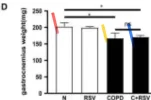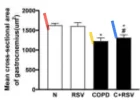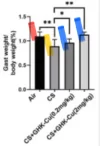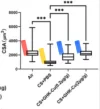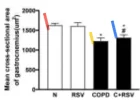SubparMarioBro
Member
I found two studies recently that are nothing short of fascinating to me. GHK-Cu is a 50+ year-old peptide that has been used quite a bit for aesthetic purposes and most of the studies on it are focused in that direction. Folks inject it subq or mix it with hyaluronic acid and apply it topically for skin benefits.
But there have been two studies that came out in the past three years that found something really cool: it directly activates SIRT1.
https://pmc.ncbi.nlm.nih.gov/articles/PMC10235902/
https://www.sciencedirect.com/science/article/pii/S0753332223007266
And it doesn’t just directly activate SIRT1, it potently activates SIRT1. For awhile resveratrol was one of the darlings of the biohacking world due to studies suggesting it could activate SIRT1, but we can actually compare their efficacy in this regard.
The first study above is regarding cigarette smoke induced muscular dysfunction and there’s a similar study that was done with resveratrol. Let’s look at the resveratrol study first.
https://pmc.ncbi.nlm.nih.gov/articles/PMC9488610/
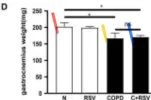
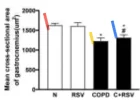
The first image shows the mass of the gastrocnemius in mice. The column with a red tag is their baseline mice. The column with the yellow tag is the mice that were exposed to cigarette smoke and not treated. The column with the blue tag is the mice that were exposed to cigarette smoke and then treated with resveratrol. In the second image we can see the cross-sectional area of the gastrocnemius. In both cases we see that the damage caused by cigarette smoke causes muscular atrophy and there’s kind of a hint that resveratrol helps to reduce this a little bit.
How does GHK-Cu compare?
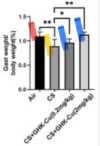
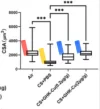
The first image is our gastrocnemius weight and the second is our cross-sectional area. This time we have two dosages that were tested, 0.2mg/kg and 2mg/kg. Unlike resveratrol where we could barely see a hint that it might be doing something, here we see significant improvement at the lower dosage and near normalization at the higher dosage.
If you dig through those first two papers I linked, there’s a lot more data making a comprehensive case that this is an effect of direct SIRT1 activation including molecular docking and the activation of downstream pathways.
SIRT1 has been an interesting but challenging drug target. Resveratrol became popular because it was thought that it could activate SIRT1 with benefits for health and longevity. Unfortunately it has very limited effect on SIRT1. Other drug candidates have also suffered from poor bioavailability and off-target effects. So it’s exciting to find an injectable peptide with excellent bioavailability that can effectively activate SIRT1 at clinically relevant dosages (the dosages you see in the muscular dysfunction study are similar to dosages used for aesthetic purposes, adjusted for species differences).
And being as this is Meso, let’s talk about the most important thing about SIRT1.
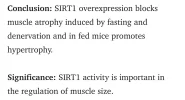
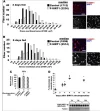
https://pmc.ncbi.nlm.nih.gov/articles/PMC3798522/
But there have been two studies that came out in the past three years that found something really cool: it directly activates SIRT1.
https://pmc.ncbi.nlm.nih.gov/articles/PMC10235902/
https://www.sciencedirect.com/science/article/pii/S0753332223007266
And it doesn’t just directly activate SIRT1, it potently activates SIRT1. For awhile resveratrol was one of the darlings of the biohacking world due to studies suggesting it could activate SIRT1, but we can actually compare their efficacy in this regard.
The first study above is regarding cigarette smoke induced muscular dysfunction and there’s a similar study that was done with resveratrol. Let’s look at the resveratrol study first.
https://pmc.ncbi.nlm.nih.gov/articles/PMC9488610/


The first image shows the mass of the gastrocnemius in mice. The column with a red tag is their baseline mice. The column with the yellow tag is the mice that were exposed to cigarette smoke and not treated. The column with the blue tag is the mice that were exposed to cigarette smoke and then treated with resveratrol. In the second image we can see the cross-sectional area of the gastrocnemius. In both cases we see that the damage caused by cigarette smoke causes muscular atrophy and there’s kind of a hint that resveratrol helps to reduce this a little bit.
How does GHK-Cu compare?


The first image is our gastrocnemius weight and the second is our cross-sectional area. This time we have two dosages that were tested, 0.2mg/kg and 2mg/kg. Unlike resveratrol where we could barely see a hint that it might be doing something, here we see significant improvement at the lower dosage and near normalization at the higher dosage.
If you dig through those first two papers I linked, there’s a lot more data making a comprehensive case that this is an effect of direct SIRT1 activation including molecular docking and the activation of downstream pathways.
SIRT1 has been an interesting but challenging drug target. Resveratrol became popular because it was thought that it could activate SIRT1 with benefits for health and longevity. Unfortunately it has very limited effect on SIRT1. Other drug candidates have also suffered from poor bioavailability and off-target effects. So it’s exciting to find an injectable peptide with excellent bioavailability that can effectively activate SIRT1 at clinically relevant dosages (the dosages you see in the muscular dysfunction study are similar to dosages used for aesthetic purposes, adjusted for species differences).
And being as this is Meso, let’s talk about the most important thing about SIRT1.


https://pmc.ncbi.nlm.nih.gov/articles/PMC3798522/
Attachments
Last edited:


